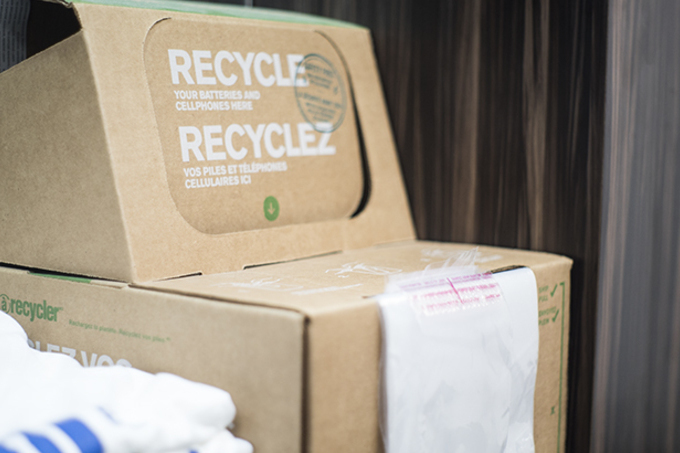« DashVapes Blog
Forward
Batteries are portable sources of power. They provide the ability to power different electrical components on the go, such as phones or laptops. For electronic cigarettes there are a large selection of batteries - and it's important to select the ones that fit your device and your needs. Batteries operate by exploiting certain chemical properties of different materials. Batteries have two terminals - the positive (cathode) and negative (anode). These are separated by an electrolyte (a material that allows the flow of ions) so that when the battery is placed into a circuit, current can flow through the battery and be used as power.
Anatomy
In order to understand the following section, you must be sure which end of your battery is which.
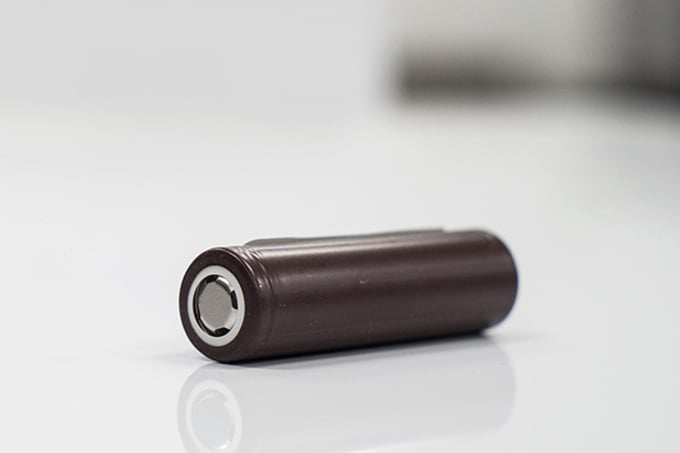
These are examples of the positive (+) end of two different batteries, the one on the left having a button top, and the one on the right having a flat top. Some devices require that a specific form of battery is used so it is important to understand which goes into your device. Neither tops affect the performance of the battery.
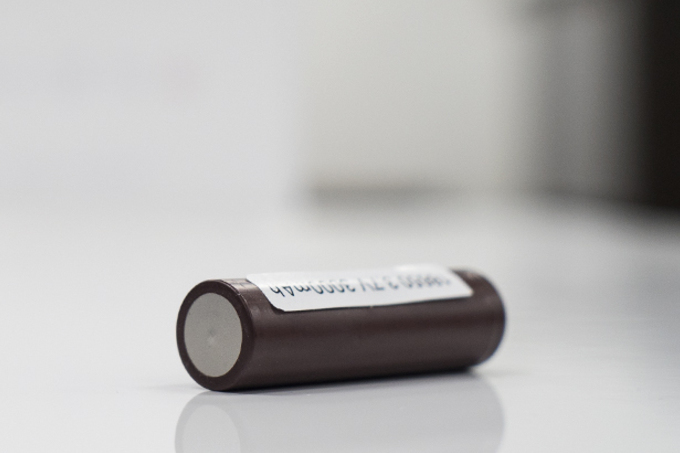
These are examples of the negative (-) end of two different batteries. The example on the left has a slightly recessed bottom (the wrapper covers the bottom) and the example on the right has a slightly protruding wrapper (there is a raised platform on the battery). Neither end affects the performance of the battery.
Do's and Don'ts
- Before we delve deeply into the more technical aspects of batteries, there's a couple points to be noted regarding how batteries should be used. No matter which device you put your batteries in, follow these guidelines for safety:
- Make sure your battery is inserted correctly (positive and negative going in the right direction)
- Make sure that whatever device your battery is going into is not applying a strong amount of pressure on the battery
- Make sure the device is free of debris
- Never carry batteries loosely without a case or something to cover them (the positive and negative ends must be covered by a non-conductive material, such as plastic)
- Never store batteries with metal, such as coins or keys
- If the device you're using does not have an off mode or lock, remove the battery when not using it or supervising it
- Don't use a battery if the wrapper is damaged
- Don't overcharge or over discharge a battery
- Don't use a battery if you don't know it's specifications
A Closer Look
There are many different kinds of batteries used for electronics. For electronic cigarettes, they are primarily lithium ion batteries - batteries composed of lithium and a complimentary material (the cathode).
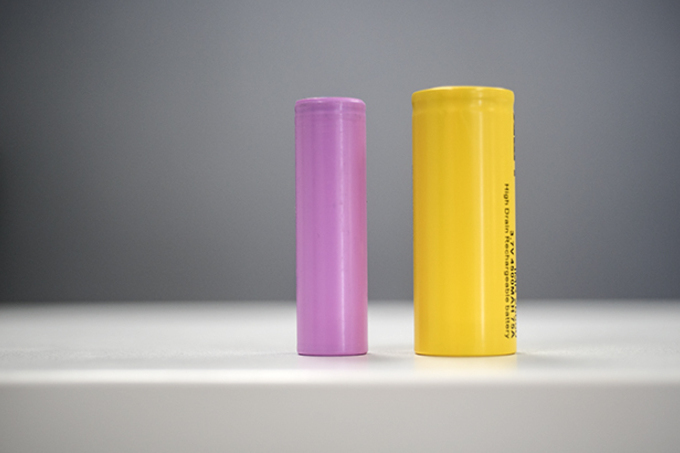
The properties of a battery depend on the material used for the cathode in the composition. The material used can determine the capacity of the battery, its ability to handle being stressed, and the voltage it can deliver. For electronic cigarettes there are two main batteries used - Lithium Ion Manganese Oxide batteries and Lithium Iron Phosphate batteries. Lithium Ion Manganese Oxide batteries have the ability to put out a lot of power safely, have a great capacity, and are considered "safe chemistry" - they react less violently than other batteries when overstressed. These are the batteries most commonly used in electronic cigarettes, particularly in mechanical mods and devices with removable batteries. Lithium Iron Phosphate batteries also have a great capacity, and can output even more power than Manganese Oxide batteries - however, Lithium Iron Phosphate batteries are NOT "safe chemistry" and react very violently when overstressed.
Naming
Batteries come in various sizes and shapes. There is a standard naming convention for referring to the chemistry, width, and length of a battery.

A - 14500 | B - 18350 | C - 18490 | D - 18650 | E- 26650 |
Typically a battery name will be in the format of three letters which refer to the chemistry, and then five numbers that refer to the size. The format for naming batteries are CCCDDLLT. CCC refers to the composition, DD refers to the diameter, LL refers to length, and T refers to type (shape). Let's take a look at the following example:
IMR18650.
I - This is a Lithium Ion battery.
M - This refers to the other constituents (the cathodes) of the battery, in this case the M means Manganese Oxide. Other common examples are C for cobalt, F for iron phosphate, and N for Nickel/Manganese oxide.
R - Indicates the shape of the cell, with R referring to round.
18 - Refers to the diameter of the battery in millimeters. Common numbers are 18 mm and 26 mm, with smaller batteries used for niche purposes such as 14 mm and 16 mm.
65 - The length of the battery, so in this case 65 mm. Other common lengths are 49 mm or 50 mm, or 35 mm.
0 - Refers to the shape once again, in this case the 0 means the battery is round. Batteries each have different capabilities based on their composition. There are several different specifications related to batteries that are important to us as electronic cigarette users.
Nominal Output Voltage
Batteries start at their full output voltage when fresh off a charger and decrease in voltage as they are drained. IMR (Lithium Ion Manganese Oxide) batteries have a nominal voltage of 3.7 volts. This refers to the average voltage that a battery will output when taken from full charge to it's lowest charge. The highest voltage that most IMR batteries can be charged up to is 4.2 volts, and the lowest they can typically be discharged (without overstressing them, or pushing them down beyond the point of still holding a charge) is 3.0 volts. So IMR batteries when fully charged discharge 4.2 volts when put in a circuit without a regulator (mechanical mod), and as they are used discharge lower rates.
Capacity
Battery capacity is measured in milliamp hours, which is how many milliamps can be drained from the battery over a period of time. Once you determine how many amps are being drawn from your battery (refer to our Ohm's Law article for help with this) you can see how long you can have your battery actually on.
C Rating (Discharge Rating)
Batteries have a limit to how much current (or Amperes) you can pull from them without overstressing them. The C Rating (or Coulomb Rating) informs you how many amps you can pull from a battery safely. The C rating is a multiplier, so you apply it to the milliamp hours of the battery to determine the maximum discharge rating of a battery. For instance, let's look at a battery with a C rating of 10 and a 2000 milliamp hour capacity. The C rating is in amps, so we have to convert milliamps to amps in order to do our math. 2000 milliamps is equal to 2 amps. Then we just multiply our C by the amps. 10 (C) x 2 (A) = 20 amps, meaning this battery can discharge 20 amps safely.
Overstressing/Thermal Runaway/Venting
When a battery is overstressed it undergoes what is known as thermal runaway. This is when the insides of the batteries undergo a chemical reaction that generates heat (which in turn causes the reaction to become more severe) and gas. The severity of the reaction is determined by the power density of the battery (capacity) and its composition. What situation causes a battery to enter thermal runaway? There are several situations that can lead to thermal runaway. Pulling too much current (amps), overcharging a battery, over discharging a battery, or hard impact can all cause a battery to enter thermal runaway. The primary reason IMR batteries are used in electronic cigarettes is because of their "safe chemistry". When these batteries enter thermal runaway the reaction is relatively slow (when compared with other kinds of batteries). When IMR batteries enter thermal runaway they produce heat, gas, and fire. If a battery enters thermal runaway and is inside a device that doesn't have holes for the gas and fumes to escape, the pressure will build up and cause the device to burst. This is why extraordinary caution must be taken when using devices that have no protection mechanism (mechanical mods, box mods, etc.). If you encounter a thermal runaway situation, do not drop your device. It will be incredibly hot, causing the metal to be more fragile. Do your best to place your device in a non-flammable environment and leave. Give the battery lots of time to finish the reaction and clean up afterwards. Do not attempt to remove the battery as you may burn yourself or inhale the noxious fumes. It is better to damage the device than it is to damage yourself!
Charging
Many units have built in charging, but when using an external charger you must make sure that the charger is able to charge the chemistry of your battery. Many chargers available to vapers (for example, the NiteCore D series, or the VP series by Xtar) are able to charge different kinds of batteries. Be certain to set the voltage for charging to match that of IMR batteries when charging (for instance, 3.6 volts on the Xtar VP2).
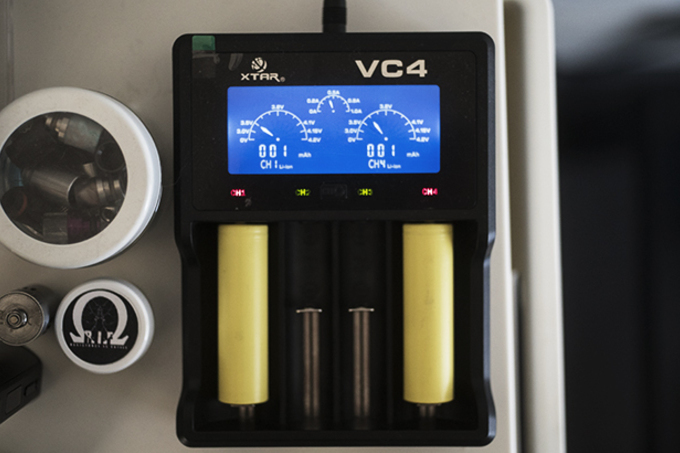
Charge Cycles and Internal Resistance
As you charge and discharge IMR batteries, they will develop what's known as internal resistance. This is part of what determines how accurately the batteries deliver their voltage to the load (atomizers, in this case). As you discharge and charge the batteries the internal resistance will increase, causing them to deliver their voltage less efficiently. This also factors in to how many charge cycles a battery can go through - as internal resistance increases the battery will be less capable of holding its charge. Internal resistance builds faster if batteries are stressed harder (or closer to their discharge limits).
Multiple Battery Devices
For devices that use multiple batteries, it is important to use a married pair of batteries. This means that the batteries were acquired together (from the same manufacturing run) and are charged and discharged at identical rates (basically, only in devices that use multiple batteries together). For instance, if using a device such as a Sigelei 150 W, the pair of batteries used must be used together. The reason for this is that if the batteries are used at different rates and under different loads, the internal resistances of the batteries will be different from each other. When the batteries are then used, the load may be uneven on one battery over the other. If the load is uneven enough, one of the batteries may be stressed to the state of thermal runaway.
Disposing of Batteries
Once batteries have reached a point when they no longer hold their charge as long as needed for one's needs, caution must be taken when discarding them. Batteries contain many toxic chemicals inside and should be safely recycled at a designated battery recycling point. You can find a drop off location for battery recycling here or just simply bring your battery to any of our stores for safe disposal.
